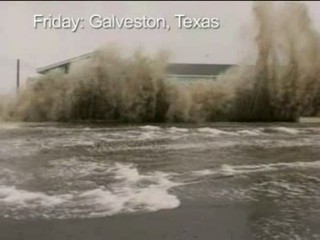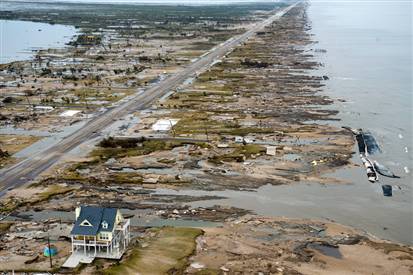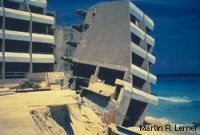-----------
Bolivar Peninsula
 Aerial
photography
of
Bolivar
Peninsula,
TX,
on
September 9, 2008 (top) and September 15, 2008, two
days after landfall of Hurricane Ike (bottom). U.S. Geological Survey.
|
|
 |
National Geographic video clip showing the effect of the storm surge (wind-driven abnormally high tide) |
|
mp4
(Quicktime,
etc.) |
|
 |
|
 Coast
Guard
Fly-Over
-
The
image
above
was taken Sunday (9/14/2008), and shows a lone house in
Gilchrist, Texas, on the Bolivar Peninsula.
|


Storm
surge
is
simply
water that is pushed toward the shore by the force of
the winds swirling around the storm. This advancing surge combines with
the normal tides to create the hurricane storm tide, which can increase
the mean water level 15 feet or more (see diagram, lower left). In
addition, wind driven waves
are superimposed on the storm tide. This rise in water level can cause
severe flooding in coastal areas, particularly when the storm tide
coincides with the normal high tides. Because much of the United
States' densely populated Atlantic and Gulf Coast coastlines lie less
than 10 feet above mean sea level, the danger from storm tides is
tremendous.
Wave and current action associated with the tide also causes extensive damage. Water weighs approximately 1,700 pounds per cubic yard; extended pounding by frequent waves can demolish any structure not specifically designed to withstand such forces.
The currents created by the tide combine with the action of the waves to severe
ly erode beaches and coastal highways. Many buildings withstand hurricane force winds until t
heir foundations, undermined by erosion, are weakened and fail.
In estuaries and bayous, intrusions of salt water endanger the public health and send animals, such as snakes, to flee from flooded areas and take refuge in urban areas. (http://www.nhc.noaa.gov/HAW2/english/storm_surge.shtml)
